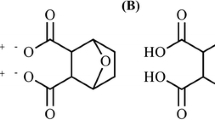Abstract
Acute toxicity data and hazard assessments were developed for three cladoceran species, Ceriodaphnia dubia, Daphnia pulex, and Daphnia magna, and juvenile Coho salmon, Oncorhynchus kisutch after exposure to the insecticide, spinosad and adjuvant R-11. The effect of a mixture of these compounds was also determined with C. dubia and O. kisutch. Spinosad was virtually non-toxic to O. kisutch. Hazard assessments indicated that R-11 posed no hazard to any of the species tested while spinosad only posed a hazard to C. dubia. Mixture studies indicated that spinosad and R-11 may interact synergistically in C. dubia.
Similar content being viewed by others
References
Abbott WS (1925) A method of computing the effectiveness of an insecticide. J Econ Entomol 18:265–267
Bakke D (2003) Human and ecological risk assessment of nonylphenol polyethoxylate-based (NPE) surfactants in Forest Service herbicide applications. United States Department of Agriculture (USDA), Forest Service. 2003. Unpublished report by David Bakke, Pacific southwest regional pesticide-use specialist. May 2003. p 182. http://www.fs.fed.us/r5/spf/fhp/pesticide/index.shtml
Crouse GD, Sparks TC, Schoonover J, Gifford J, Dripps J, Bruce T, Larson L, Garlich J, Hatton C, Hill RL, Worden TV, Martynow JG (2001) Recent advances in the chemistry of spinosyns. Pest Manag Sci 57:177–185
Curran CA, Grassley JM, Grue CE (2004) Toxicity of R-11 surfactant to juvenile rainbow trout: does size matter? Bull Environ Contam Toxicol 72:401–408
DowElanco (1996) Spinosad technical guide. Form No. 200-03-001 (4/96)
Federal Register (2005) Spinosad; notice of filing a pesticide petition to establish a tolerance for a certain pesticide chemical in or on food. Volume 70, Number 138. [Notices] [pp 41730–41735] From the Federal Register Online via GPO Access [wais.access.gpo.gov] [DOCID:fr20jy05–67]
Finney DJ (1971) Probit analysis, 3rd edn. Cambridge University Press, Cambridge
FQPA (Food Quality Protection Act), Congress (1996) US Public Law 104-170. 104th Congress, August 1996
Goldman LR (1998) Linking research and policy to ensure children’s environmental health. Environ Health Perspect 106(Suppl 3):857–862
NRC (National Research Council) (1993) Pesticides in the diets of infants and children. National Academy Press, Washington
SAS Institute (1999) SAS/STAT user’s guide, version 6. Institute, Cary
Smith BC, Curran CA, Brown KW, Cabarrus JL, Gown JB, McIntyre JK, Moreland EE, Wong VL, Grassley JM, Grue CE (2004) Toxicity of four surfactants to juvenile rainbow trout: implications for use over water. Bull Environ Contam Toxicol 72:647–654
Stark JD, Banks JE (2001) Selective pesticides: are they less hazardous to the environment? Bioscience 51:980–982
Stark JD, Vargas RI (2003) Demographic changes in Daphnia pulex (Leydig) after exposure to the insecticides spinosad and diazinon. Ecotoxicol Environ Saf 56:334–338
Stark JD, Walthall WK (2003) Agricultural adjuvants: acute mortality and effects on population growth rate of Daphnia pulex after chronic exposure. Environ Toxicol Chem 22:3056–3061
Trumbo J (2005) An assessment of the hazard of a mixture of the herbicide Rodeo and the non-ionic surfactant R-11 to aquatic invertebrates and larval amphibians. Calif Fish Game 91:38–46
USEPA (1991) Methods for measuring the acute toxicity of effluents and receiving waters to freshwater and marine organisms. EPA/600/4-90/027. Environmental Monitoring and Support Laboratory, US. Environmental Protection Agency, Cincinnati
USEPA (2002) Short-term methods for estimating the chronic toxicity of effluents and receiving waters to freshwater organisms, 4th edn. EPA/600/4-89/001
Wilbur-Ellis (2007) R-11 material safety data sheet. http://www.cdms.net/ldat/mp956000.pdf
Acknowledgments
Special thanks to Maria Boroja, NOAA, Washington, DC for financial support. We are grateful to Nathaniel Scholz and Cathy Laetz, NOAA, Seattle, Washington for their help and advice with regard to Coho research. We thank Grace and Oriki Jack for technical support. We also thank Drs Allan Felsot and Carol Anelli who served as committee members for Angela Deardorff’s Master Thesis project. This project was funded in part by NOAA.
Author information
Authors and Affiliations
Corresponding author
Rights and permissions
About this article
Cite this article
Deardorff, A.D., Stark, J.D. Acute Toxicity and Hazard Assessment of Spinosad and R-11 to Three Cladoceran Species and Coho Salmon. Bull Environ Contam Toxicol 82, 549–553 (2009). https://doi.org/10.1007/s00128-009-9643-6
Received:
Accepted:
Published:
Issue Date:
DOI: https://doi.org/10.1007/s00128-009-9643-6




